Closeouts in Jiu-Jitsu, 2010-Present: Who Did It The Most?
Closeouts in Jiu-Jitsu, 2010-Present: Who Did It The Most?
To better understand the extent of closeouts in jiu-jitsu we studied data from black belt finals in the four major IBJJF tournaments over the last 12 years.

The divisive topic of closeouts has split the jiu-jitsu community.
One one side, there are those (like us) who are opposed to the practice of entering a competition only to settle important finals with a handshake instead of fighting for a gold medal.
On the other, there are those who say that friendships are more important than medals, and that a lack of financial incentive is no reason to destroy relationships with teammates and training partners.
It's a hot topic that has been the subject of much passionate discussion, especially after four of the 10 male black belt finals were closeouts at the 2022 IBJJF Pan Championships.
The IBJJF responded by announcing measures designed to dissuade the practice at the upcoming World Championships. Stopping short of an outright ban, the rule will deny cash prizes or ranking points to any athletes who close out in the black belt finals at Worlds. It is hoped this potential forfeiture will inspire teammates to compete against each other.

Closeouts, A Brief History
Take a look at the results from the very first IBJJF World Championships that took place in 1996 and you'll see that three men's black belt finals were closeouts, including the absolute division. That trend would continue, and it wasn't until 2000 that we saw a Worlds without any closeouts.
Of course the practice existed long before this. To understand why closeouts are part of the culture of jiu-jitsu we need to go back to the 1960s and 70s to the origins of jiu-jitsu competitions. Prior to the creation of first Brazilian jiu-jitsu federation in 1967, jiu-jitsu was practiced primarily as a style of self-defense and utilized in no holds barred fights (vale tudo). With the creation of the Federação de Jiu-Jitsu da Guanabara came sanctioned tournaments much like we compete in today.
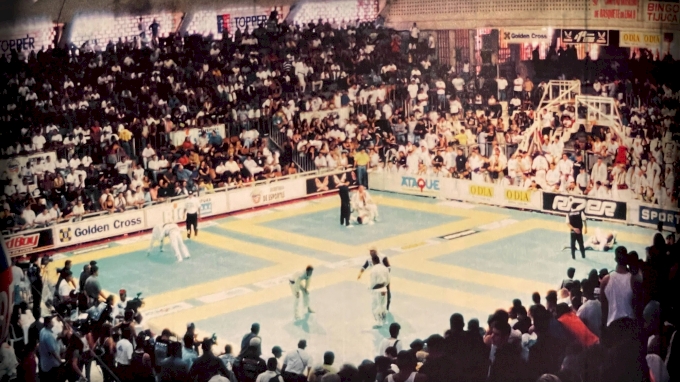
The Tijuca Tennis Club, site of the first IBJJF World Championships
During this era there was Gracie jiu-jitsu and there was everybody else. While Helio Gracie, Carlson Gracie and others had their own schools and teams of competitors, they would come together as one team at tournaments and their representatives would not face off against each other. For a family with such a prominent position, it was unthinkable to compete against each other in public, and so they would close out if they met in the finals. This would gradually change over time as divisions grew between the team leaders. From the 1980s on, Carlson, Helio and Carlos Gracie Jr's teams all engaged in intense rivalries.
Jiu-jitsu has grown to become a globally-practiced martial art but the community of team coaches and competitors remains tight-knit. Many active competitors share similar origins, with some being childhood friends. Some come from the same small gyms in the same hometowns, and the strength of these relationships can be hard to appreciate for outsiders.
It is very common in both major and minor tournaments for competitors from the same teams to decline to compete against each other in jiu-jitsu tournaments. The tradition originated with Brazilian athletes and has since been picked up by others, continuing unabated into the modern era.

A Study of Closeouts in Jiu-Jitsu Competition, 2010-Present
To better understand the extent of closeouts in jiu-jitsu I studied data from major IBJJF tournaments over the last 12 years, analyzing the black belt finals from the World, Pan, European and Brazilian National Championships. These four events are known as the IBJJF "majors".
By collating the results we were able to calculate:
- How many finals ended via closeout
- The events where closeouts were most common
- Which teams were responsible for closing out finals
- Which athletes closed out the most
- The weight divisions where closeouts were most common
- Frequent collaborators, athletes that closed out together the most
- How often teams did not engage in closeouts
This information helps us understand how much of an impact closeouts have had on the sport in the modern era. Scroll down for and overview of each area of study.

How Many Closeouts Have There Been?
The competition data studied includes the male and female black belt finals from 2010 to present. Note that until 2011 the women's divisions were combined brown-black belt.
We decided to focus on results from 2010 to present as there was more information available about which finals were closeouts, and which finals were disputed between teammates.
We identified five possible outcomes to the total 815 finals: finals that took place, finals that were closed out, a match that was forfeited due to injury, and a single case of a semifinalist being crowned the winner due to both finalists being DQ'd.
- Of the 815 finals, 106 (13.01%) were closeouts where the result was agreed upon and no match took place.
- 23 finals featured two members of the same team fighting against each other, although this only accounted for 3.2% of all finals.
Above you can see the IBJJF major events where closeouts were most common.
- The closeout rate at Pans and Euros was significantly higher than at Worlds or the Brazilian Nationals.
- The closeout rate at Pans was nearly 2.5x greater than that of Worlds, while Euros matches were twice as likely to close out more than Worlds.
- Overall, men were four times more likely to close out than women.
- No more than two closeouts took place at a single World Championship. The most closeouts at Pans was 5 in one year, and 6 in one year at Euros (40% of all finals that year).

Closing Out: A Team Effort
- The powerhouse team Alliance dominated the sport jiu-jitsu competition scene for over a decade, and their high success in competition was bolstered by the fact they closed out more finals in major events than any other team.
- Alliance closed out 1.7 times more finals than the next team Atos.

Alliance team leaders Fabio Gurgel, Romero Jacare and Gigi Paiva on the podium at the 2019 IBJJF World Championships

Who Closed Out The Most?
- Below is a list of 15 athletes who closed out in the major tournaments four or more times. This does not mean they always took the gold medal, but that they were involved in a closed-out final.
- As I will expand upon below, many times they operated with a certain partner or partners in closing out finals.
- There were a further 18 athletes who closed out more than once, and the remaining 66 athletes in our study only closed out once.
- Every athlete on this list is Brazilian.
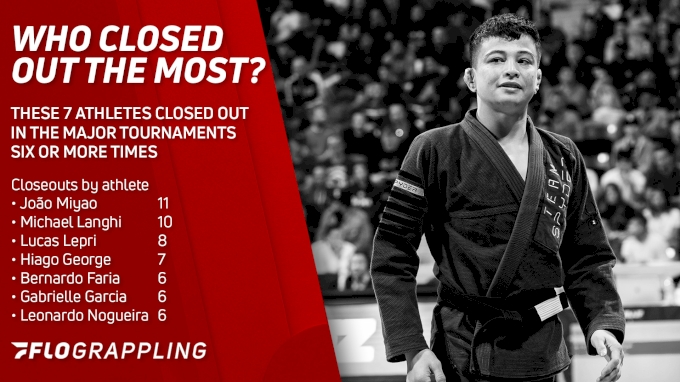

The Finals Least Likely to Happen
While light-feather and lightweight were closed out 15 times between 2010-2015, there was no great difference between divisions most likely to close out.
- Certain teams ruled certain divisions when it comes to closeouts:
- Cicero Costha’s dominance at light-featherweight (Joao Miyao and co) closed out 13 of 15 finals, a total of 86%
- Alliance’s stronghold of the lightweight division (Langhi and Lepri, plus others) saw them close out 11 of 14 lightweight finals (78%)
- Atos closed out the most finals at medium-heavyweight, with 7 out of 11 (or 63%).

Frequent Collaborators
As I mentioned above, closeouts commonly happen between two trusted partners from the same team. Equally skilled and capable of making it into the finals, they close out and share the accolades, often taking it in turns to take photos while holding the gold medal and describing the achievement as a shared gold medal. Oftentimes a competitor will list themselves as an X-times champion, counting the occasions when it was their partner who was actually registered on the results page as taking the gold medal. There can only be one champion, and this should be considered when truthfully counting how many titles a competitor claims to have.
In cases where the teammates closing out are of an equal standing in the team, they often make sure to take turns in being registered as the official gold medalist.
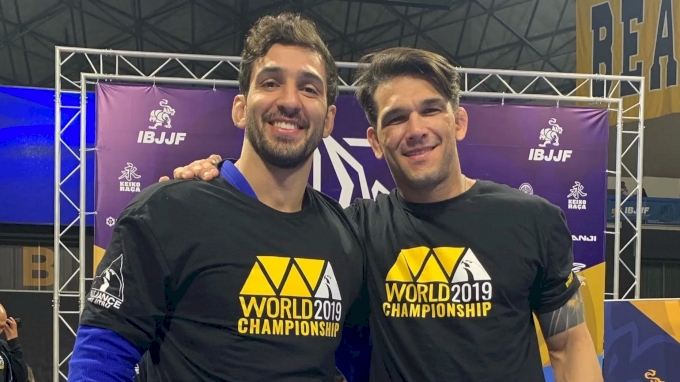
Lucas Lepri and Michael Langhi
Alliance veterans Michael Langhi and Lucas Lepri closed out together 7 times from 2010 to 2015. In 7 closeouts with Lepri, Langhi took gold 4 times (Worlds x1, Pans x2, Euros x1), Lepri took gold 3 times (Pans x2, Euros x1).
Langhi also closed out with Juan Kamezawa x2, and Francisco Iturralde x1.

Joao Miyao & Cicero Costa teammates
Joao Miyao had three frequent closeout collaborators from the Cicero Costa team, working with:
- Paulo Miyao 4 times
- Tiago Barros 3 times
- Hiago George 4 times
In 11 closeouts, Joao Miyao took gold 6 times: twice with Paulo (Worlds x1, Pans x1), twice with Tiago Barros (Pans x1, Brasileiros x1), and twice with Hiago George (Euros x2).
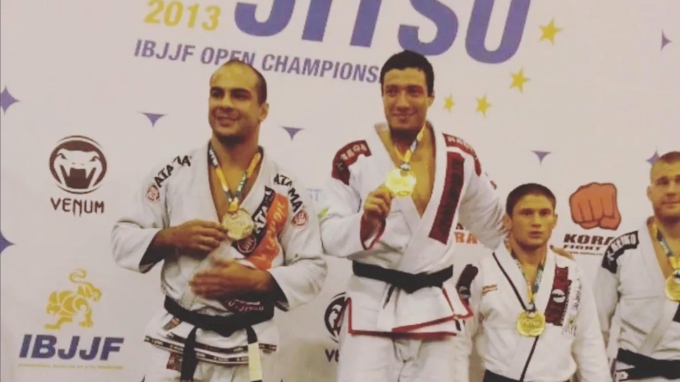
Bernardo Faria and Leo Nogueira
Alliance teammates Bernardo Faria and Leo Nogueira closed out together a total of 5 times (Worlds x1, Pans x1, Euros x2, Brasileiros x1). In 5 closeouts, Nogueira took gold 3 times and Faria took gold twice.
Gabi Garcia and Luanna Alzuguir
Gabi Garcia and Luanna Alzuguir, former Alliance teammates, closed out together 5 times. In 5 closeouts together, Garcia took gold 3 times (Pans x1, Euros x1) while Alzuguir took gold twice (Worlds and Pans)

Gustavo Batista and Lucas Barbosa
Atos teammates Gustavo Batista and Lucas Barbosa have closed out together four times, taking gold 2 times each (Worlds x2, Pans x2).
No Closeouts: When Teammates Face Off
- It is not totally unheard of for representatives of the same team to compete against other in the final, although this is uncommon.
- There were only 23 recorded instances of teammate vs teammates in a final, amounting to just 3.2% of all disputed finals.
- While Alliance lead the way with the most number of closeouts, they were also most likely to put teammate against teammate to see who would be crowned winner.
- In the 23 finals between teammates, 14 featured a Brazilian vs a non-Brazilian (60%) while the remaining 40% was Brazil vs Brazil.
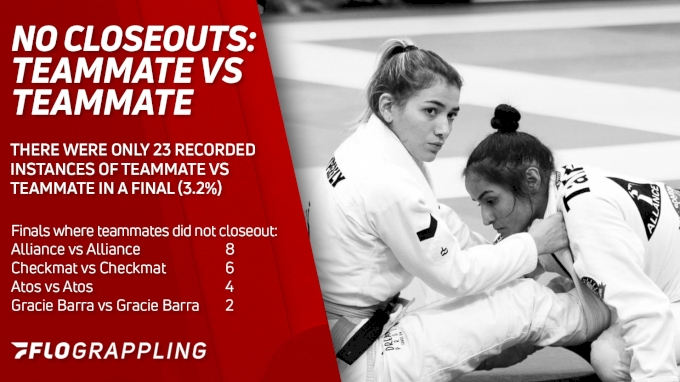
Anna Rodrigues vs Talita Alencar at 2020 Euros: Alliance vs Alliance
Alliance vs Alliance
- Luanna Alzuguir vs Luiza Monteiro, 2011 Worlds
- Dominyka Obelenyte vs Monique Elias, 2015 Worlds
- Gianni Grippo vs Rubens Charles, 2017 Euros
- Marcos Tinoco vs Alec Baulding, 2017 Euros
- Cleito Soares de Resende Junior vs Hiago Gama, 2018 Euros
- Isaac Doederlein vs João Paulo Gonçalves Neto, 2019 Brasileiros
- Ana Rodrigues vs Talita Alencar, 2020 Euros
- Fellipe Andrew vs Vinicius Ferreira, 2022 Euros
Atos vs Atos
- Jonathan Torres vs Claudio Calasans, 2014 Euros
- Michael Liera Jr. vs Alex Cabanes, 2016 Euros
- Gustavo Batista vs Dominique Bell, 2020 Pans
- Bianca Basilio vs Gabrielle Mccomb, 2020 Worlds
Checkmat vs Checkmat
- Marcus Almeida vs Alexander Trans, 2012 Pans
- Michelle Nicolini vs Marina Ribeiro, 2012 Worlds
- Marcus Almeida vs Alexander Trans, 2013 Pans
- Alexander Trans vs Rodrigo Cavaca, 2013 Worlds
- Marcus Almeida vs Alexander Trans, 2014 Worlds
- Ivaniel Oliveira vs João Pedro Rodrigues, 2014 Brasileiros
GF Team vs GF Team
- Ana Carolina Vieira vs Laurah Hallock, 2019 Worlds
Gracie Barra vs Gracie Barra
- Romulo Barral vs Rodrigo Fajardo, 2013 Euros
- Augusto Carsalade Vieira vs Claudio Cardoso, 2015 Brasileiros
Gracie Elite Team vs Gracie Elite Team
- Talita Nogueira vs Carolyn Stephenson, 2014 Pans
Gracie Humaita vs Gracie Humaita
- Emilie Thylin vs Mackenzie Dern, 2017 Euros

Closeouts: Part Of The Culture
The IBJJF’s recent measures were never meant to be a ban on closeouts, as the ruling leaves the agency with the teams and athletes to still close out if they wish. Closeouts are an entrenched part of the jiu-jitsu culture, as we can see. It’s not easy to counter 25+ years of history.
When a Brazilian competitor meets a teammate in the final, they are far more likely to close out even if they don’t train together. This is the most often the result of tradition combined with a set of cultural values not always shared by other competitors, but something also subject to outside forces.
It cannot be overlooked that the athletes themselves don’t always have control on whether they will compete or not. I’ve heard from many competitors who received instructions from a coach or senior team leader that a match with a teammate is out of the question, and the result was dictated to them. In a hierarchical structure like a global jiu-jitsu team, decisions come from the top.
How many closeouts are too many? Over 13% of black belt finals didn’t take place at the IBJJF majors– for us here at FloGrappling, this is too many. There is no benefit to anybody should the “winners” claim gold medals via agreement. It simply lessens the value of their title.
There are some simple solutions to the problem: seeding competitors on the same side of the bracket would be an immediate fix. You can’t have a closeout as long when two teammates don’t meet in the final. They may forfeit an earlier-round match, but the final decisive match that announces the champion would take place, which is most important.
Athletes have called for better compensation, arguing they will compete so long as cash prizes are on offer. Yet they routinely decline competing in tournaments where closeouts are prohibited and cash prizes are offered, a single they value the prestige of an IBJJF title more than anything. And even though the IBJJF offers between $4,000 to $10,000 for their black belt champions some competitors complain this is not enough, although I've not yet seen anyone propose a reasonable expectation of what the cash prize should be.
Without direct measures, it’s likely closeouts will continue to take place at the majors, and possibly even Worlds. The IBJJF should be commended for addressing the problem, and hopefully the teams and athletes take up the challenge –make jiu-jitsu watchable, and put on great finals matches that people will talk about for years to come.